(This story includes news and opinion.)
Three people have died while using a 1.4-mile stretch of Martin Luther King Jr Blvd in northeast Portland in the past three years — and two of the preventable tragedies happened in the past month.
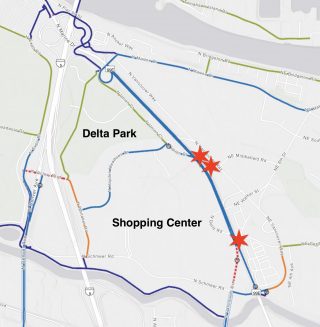
Just after sunset on Friday, 64-year-old Gene Courtney was bicycling northbound in a marked bike lane. According to a statement from the Portland Police Bureau, a driver noticed Courtney was “weaving in their own bike lane”. The driver claims that Courtney then “abruptly maneuvered” left before being hit. “The unanticipated lane intrusion appears to be the initiating factor for this crash,” the PPB statement reads. Courtney died on the scene.
Police and transportation agencies often tell the convenient lie that human behavior is to blame for the vast majority of collisions. But a closer look at this urban highway and how people behave on it tells a different story.
I went out to the site for a closer look on Sunday. I wanted to understand why this might have happened and maybe learn more about Courtney. I talked to a few people who live nearby, but none of them had heard of him (or they weren’t willing to share). While a portrait of Courtney has yet to emerge, the dangers of the roadway environment where he died became clear right away.
Advertisement

Martin Luther King Jr. Blvd is Highway 99E, wholly owned and operated by the Oregon Department of Transportation. In this section between N Vancouver Avenue and the Marine Drive/I-5 interchange, there are three lanes in each direction (two general vehicle lanes, one bike-only lane) separated by a concrete median that rises a few inches above the ground. Between Columbia and I-5 there are no signals or crossings of any kind for two miles, offering drivers a straightaway with a generous speed limit of 55 mph. It also has no streetlights.
It’s easy to see why people die on this road.
PPB Major Crash Team experts calculated that if Fivecoats would have been going the speed limit and started braking 0.13 seconds sooner, he would not have hit Holtrop.
On May 12th, 2017, a 27-year-old man named Justen Fivecoats was driving to his house in St. Johns. Just before 5:00 pm he was driving northbound on Martin Luther King Jr Blvd at over 70 mph when he noticed brake lights on the car in front of him. According to the police report (made available via a forthcoming report from attorney/advocate Scott Kocher and nonprofit Oregon Walks), Fivecoats swerved to the middle lane to pass the other driver. Fivecoats then realized why the other driver slowed down. He too slammed his brake pedal when he saw 48-year-old Toby Holtrop crossing the road in front of him. The front tires of Fivecoats’ Dodge Durango skidded for 220 feet — the length of over two basketball courts — before it slammed into Holtrop’s body at 55 mph, causing multiple blunt force injuries that killed him shortly after.
PPB Major Crash Team experts calculated that if Fivecoats — who was driving 15 mph over the speed limit, had been up for 16 hours, and had “significant amounts” of THC in his body — would have been going the speed limit and started braking 0.13 seconds sooner, he would not have hit Holtrop.
In the police report for this crash, the PPB officer wrote that it was Holtrop who “had created a dangerous situation.” “Mr. Holtrop chose to cross the highway with cars approaching in close proximity in both directions,” the report reads, “when a reasonable person [driver] would expect a pedestrian to wait for the roadway to be clear… before crossing.” In the end, Fivecoats was issued a citation for speeding and paid a $165 fine. (The slap on the wrist had no impact on Fivecoats. Three months later he received another citation and was ordered to pay a $440 fine for driving 71 mph in a 40 mph zone on Marine Drive.)
Advertisement
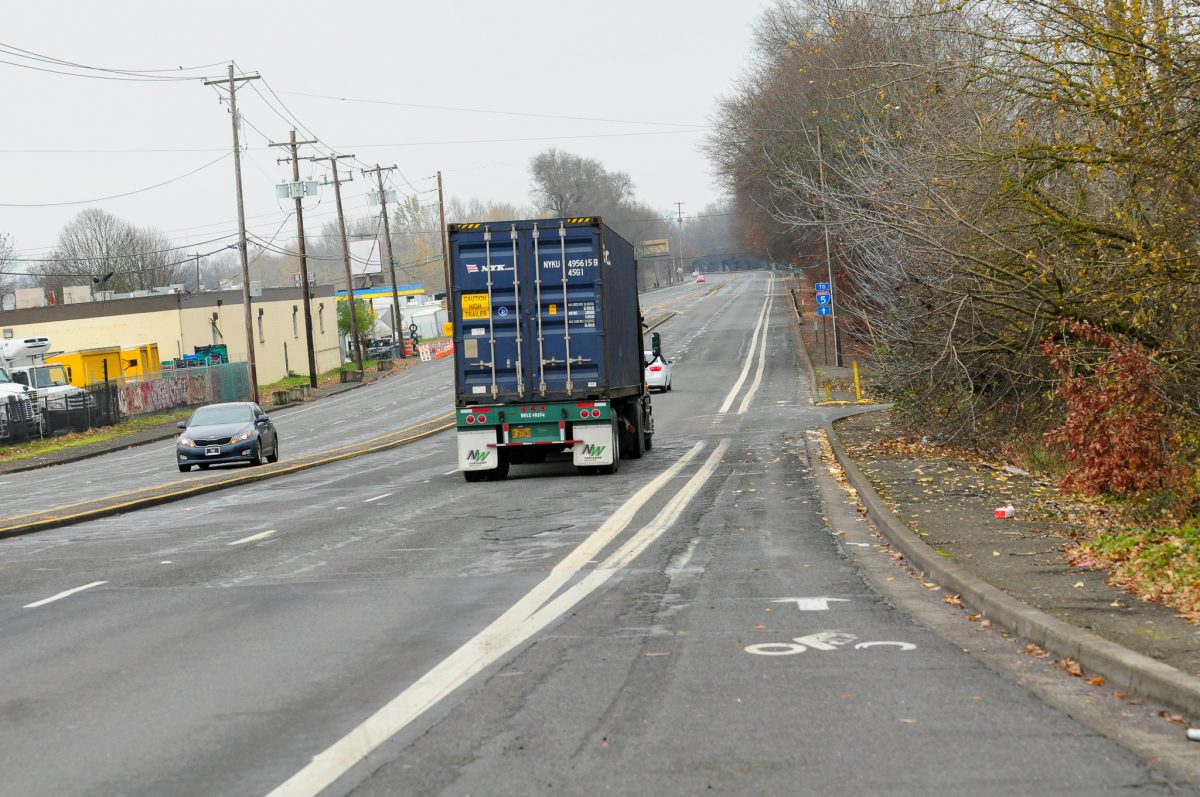
Holtrop was crossing at nearly the exact location where Courtney attempted to cross this past Friday. Why? Because it’s a spot where there’s a break in the median (for emergency vehicle access?) where Union Court merges onto the southbound lanes. The presence of Union Ct and the median break encourage people to cross, so too does the fact that there are no other places to do so. Union Ct is a convenient mid-point between two miles with no other access to these destinations.
When you combine a lack of crossings with a dark, straight, wide, high-speed roadway where people often go too fast, you have the recipe for disaster. Martin Luther King Jr. Blvd/99E isn’t a freeway, but it feels like one and acts like one. Like other ODOT highways and “high crash corridors” Portland, it’s a serial killer whose identity everyone knows but is allowed to walk freely and have a normal life as it preps for its next victim.
Just after 2:00 am on November 19th of this year, 18-year-old Obduwier “Duvi” Romero-Moreno was driving northbound on Martin Luther King Jr Blvd just a half-mile south of where Holtrop and Courtney were killed. Romero-Moreno was by himself and apparently lost control of his car prior to leaving the roadway and hitting a nearby tree. He died later at the hospital. The investigation into Romero-Moreno’s crash in ongoing.
Too many people look the other way at these three tragedies because it’s convenient and easy to just blame the dead and move on. We shouldn’t do that. Despite what police and transportation agencies think, Highway 99E isn’t just for driving. It’s an official “Bike Route” listed on the City of Portland’s bike map and the Columbia Slough path leads directly to the same shoulder bike lane where Holtrop and Courtney took their last steps.
We can’t create these conditions, encourage people to use an inherently dangerous road, and then say their behavior was “unreasonable”. A pillar of the City of Portland’s Vision Zero strategy is to design “safe systems” which means, “designing streets to protect people even when they make mistakes.” What protection do we provide people on this section of Martin Luther King Jr Blvd? If the answer is none, then we are complicit in this death. And the next one, and the next one, and…
— Jonathan Maus: (503) 706-8804, @jonathan_maus on Twitter and jonathan@bikeportland.org
— Get our headlines delivered to your inbox.
— Support this independent community media outlet with a one-time contribution or monthly subscription.



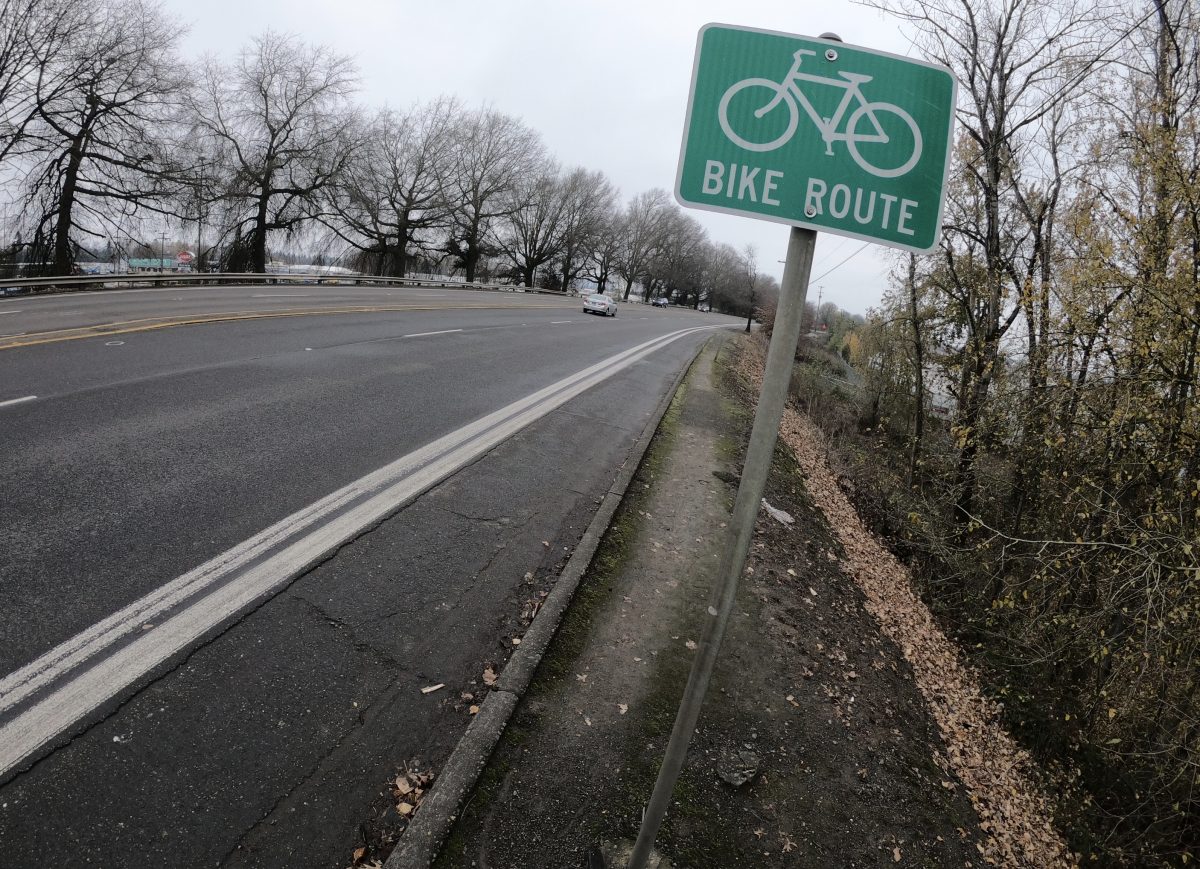




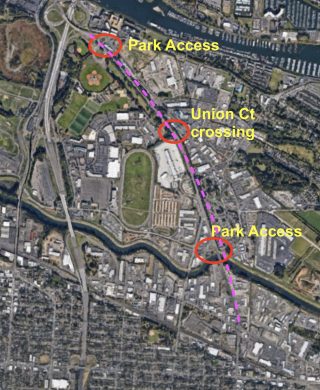
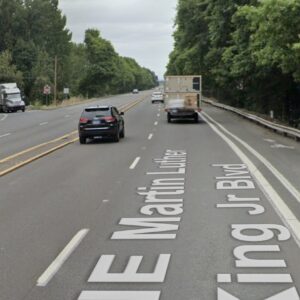



Thanks for reading.
BikePortland has served this community with independent community journalism since 2005. We rely on subscriptions from readers like you to survive. Your financial support is vital in keeping this valuable resource alive and well.
Please subscribe today to strengthen and expand our work.
Exactly the same dark-natural-crossing-high-speed area as kills many between Hillsboro and Cornelius.
I had a close call a few years back crossing MLK near River City Bikes in broad spring daylight (so much, much further south): there’s actually a crosswalk light there, and so I used it to cross. We were almost to the other side and the hand was blinking when I felt a breeze across my legs. Someone had blown right through their red light and very *very* nearly hit me. Kept going too, of course!
I don’t remember where the car had come from (turning?) because the rest of the traffic was stopped. Well-lighted crosswalks make crossing safer but apparently not safe enough for the most boneheaded or inattentive of drivers.
I am sad to hear of another human death along this dangerous corridor.
Creating an enhanced pedestrian crossing in this section makes a lot of sense given the land uses and poor regional connectively for those on foot / pedal.
[My memory is that this corridor started out as the old Union Ave (?) elevated streetcar line from north Portland to the Vancouver ferry…back before “Interstate Blvd” / Highway 99. Thus some of the legacy of poor connectively to surrounding land uses as this area developed under the responsibility of the county..]
East Portland now has lots of brand new enhanced pedestrian crossings, all at useful locations. Guess what is happening? Pedestrian deaths and injuries are rising. It turns out enhanced crossings have limits to their usefulness – they can’t replace driver cautiousness and defensive driving, nor pedestrians having to be constantly vigilant, nor prevent drivers from being drunk, distracted or stoned, or driving well over the speed limit, nor a total lack of traffic enforcement.
And how are pedestrians reacting? The smart ones are crossing everywhere except at enhanced crossings, since the standard design seems to encourage drivers to ignore anyone who is using the crossing, especially the driver in the other lane who can’t see the pedestrian crossing because the stopped cars are blocking their view, and such drivers lack any sort of common sense whatsoever, including that the other cars stopped for a reason.
I don’t think you can tie increased pedestrian deaths and injuries to increased numbers of new enhanced crossings. The numbers could be even worse without them.
You could say the same thing about reducing speed limits just making things more dangerous, something that people on Nextdoor do say constantly.
And the problem of people getting hit while crossing by drivers swerving around stopped cars happens at non-enhanced crossings, also. I suppose you could argue that the enhanced crossing lull crossers into a false sense of security, but that’s debatable.
Do you have evidence (citation) that this is true? When I find an enhanced crossing, I use it. And I’d like to think I’m smart enough to do so.
So the driver observed the rider weaving erratically and did not see cause to proceed with extreme caution? Damn, that’s one of my favored tactics – stimulate awareness and uncertainty to induce caution. Safety on the road is somewhat random I fear.
The driver in the 2017 crash was baked. And, while it’s never possible to eliminate all risk, there is plenty you can do to counteract the randomness and greatly improve your odds of arriving safely.
The recitation of the crash is clearly inaccurate. You don’t brake-skid for 220′ and only slow down 15 mph.
Not surprising. Most drivers don’t really think much while driving. It has become routine, and anything out of the ordinary generally surprises them.
I rode that section of road regularly for a few years when I biked to work in downtown Vancouver. The only close call I had was when some idiot decided to make a right turn half a second after passing me. Yes, speeds are high, but the shoulder is pretty wide and traffic volumes are actually rather modest. I’m always skeptical about driver’s claims about bicyclist behavior. It’s unfortunate that we will never actually know what happened.
“Police and transportation agencies often tell the convenient lie that human behavior is to blame for the vast majority of collisions. ”
The Safe Systems approach identifies multiple points of attack in order to reduce and eliminate fatal crashes from the transportation system. One of it’s primary tenets is that people using roadways have always and will forever make mistakes, driving, rolling or walking. Road user training is one of the strategies to make roads safer, as is better design. Choosing to ignore that road users, their choices, and lack of training are a primary factor in the high fatality rate in the US, and in such a mean-spirited way, is irresponsible.
Goodbye.
Hello paikiala,
In no way did I intend to make it seem like human behavior is not to blame at all. But I chose to not focus on it because it is so often the focus of too much attention in my opinion. So I’m not “choosing to ignore” road users. I see it as choosing to highlight another factor and I assume readers understand that humans make mistakes and are imminently fallible. And this “road user training” thing you talk about. What is it? We have an absolutely terrible system for doing that, and our road designs teach people the wrong behaviors.
Hello
This incident to me is a perfect illustration of the police, at least, doing exactly what Jonathan wrote. The police placed 100% of the blame for this death on the human behavior of the victim.
As you say, humans will always make mistakes using roads. In this case, it seems likely that what happened is that the victim wanted to cross the road, and made the mistake of not doing it safely.
But what if there’d been a crosswalk with a light within some reasonable distance? Or better lighting? Or a lower speed limit? Any of those might have prevented this death, even if the victim had still made some sort of mistake.
Instead, there was NO crossing within almost a mile, NO lighting at all, and the same speed limit used for freeways that have total separation of traffic, no intersections, excellent lighting, etc. The police didn’t mention any of that. They basically just said, “The victim made a mistake that caused his death”–exactly what Jonathan wrote that they do.
The crash occurred because a cycler changed lanes into one with a vehicle in it. It was 100% his fault. There are few reasonable design improvements that would have prevented the rider from being seriously injured or killed.
The driver he collided with saw him ahead of time, so lighting was not an obvious factor. A significantly lower speed limit, with regular and consistent enforcement, might have helped, as would a crossing signal (if the rider had chosen to use it… but recall that rider in Vancouver who was killed recently didn’t use a nearby signal there, and the police were roundly criticized for suggesting he should have). In any event, this location would be last on any list of potential crossing signals that was drawn up rationally. It would be (literally) a “crossing to nowhere.”
There is an underpass 1000 ft to the south of where this crash occurred; that’s not so far on a bike. Given the rider was coming from that direction, it’s quite possible he rode right past it.
This story is a sad one, but it is not a good example of how better urban road design can improve outcomes. It is, however, a good example of how riding erratically on the side of a highway can be very dangerous.
He could have prevented it from happening. Any one of the several things I mentioned might have prevented it also.
Of course there’s always the possibility someone isn’t going to use a crossing signal, but saying it might not have helped because he might not have used it gets silly.
1000′ away is pretty far if you have to ride alongside 55 mph traffic with no lighting. Maybe the lack of lighting discouraged him from trying, and that’s if he did know about it anyway.
I agree this location would be low on any priority list for a crossing. That doesn’t mean the lack of one isn’t a missing safety factor, or that the lack isn’t any less dangerous for people who do need to cross.
This road with no safe crossing for almost two miles creates a barrier between acres and acres of land east and west of it. Google any point on one side and any on the other, and see how far you have to go to get around it. And even then, that can mean riding or walking long distances on Columbia Boulevard or Marine Drive, both dangerous streets for walking or riding.
This IS a great example of riding erratically on the side of a highway can be dangerous. But it’s also dangerous to ride or walk on non-erratically, and especially to cross.
MLK on this stretch is a horrible street for anywhere within a city. It doesn’t even feel safe to drive on.
Yes, the road is a barrier for those walking from the truck stop to the raceway. It sucks. But what sways me are actual ideas for improving the system, rather than laments about how awful it all is.
There is a very long list of things that could have prevented this from happening, but the list of things that are realistic to do using any sane system of prioritization is very short.
Building a short section of fence on the west side of the street is practical, affordable, and would likely be effective. What else meets those criteria?
Sending a maintenance crew out for 4 hours to replace the 55 mph signs with 40 mph signs, for one. We know that won’t mean everyone instantly starts going 40 instead of 55, but they might drop to 50 from 65, which could make a difference.
Also, my initial comment had nothing to do with prioritization or affordability. It was a comment that the police placed all the blame on human behavior, without mentioning anything else that might have been a factor. You just said that “there is a very long list of things that could have prevented this from happening”. That’s my point. Yes, there is, but none of those got mentioned.
Someone might say that that’s because police reports don’t typically do that. Yes, that’s exactly right–they don’t. That’s why I commmented that I thought it was wrong of paikiala to take Jonathan to task for saying it.
The proximate cause is 100% human behavior, as the police reported. Stating this is not a “lie”. It is not up to the cops to make engineering judgements about what other elements could have played a role and/or how to mitigate them. That’s PBOT/ODOT’s job.
Maybe we should ask PBOT to produce a follow-up report on every crash providing an engineering analysis of what went wrong and how it could be addressed. This could be part of a parallel crash investigation team that partners with the police.
The police are a law enforcement body; asking them to step beyond this role is a mistake, which is the most powerful point that defunders make.
The statement was, “Police and transportation agencies often tell the convenient lie that human behavior is to blame for the vast majority of collisions. ”
I agree, if you want to narrow it down to the first, immediate (“proximate”) cause it’s not wrong to say it was human behavior. But I didn’t take the statement to mean that. I took it to mean that police and transportation agencies often leave it at that, and don’t consider or discuss other contributing factors. That interpretation seems clear seeing the rest of the article.
I agree it’s not up to the cops to do a comprehensive analysis. But that’s how police reports are viewed, because they are written as if they are, because there is rarely any attempt to put any sort of disclaimer on the information. And there rarely is any report by PBOT, reporters or anyone else to include information beyond the initial police report.
So I agree it would be great if PBOT did follow-up reports, and it should.
I’ve read hundreds of building fire and construction failure reports. Those don’t stop at the basic information of who broke what law. They’d be almost worthless if they did. They include all the related issues, such as those in the article above, that were not in the police report.
Also, in many (most?) types of accidental deaths, you can correctly say the victim was responsible, and his own actions led to his death. A guy drowns at the beach–his own fault. But a good analysis would mention there are no beaches in the area with lifeguards, or there was a lifeguard who incorrectly left his post for 20 minutes, or you couldn’t see the whole area from the lifeguard chair, etc. The lifeguard situation didn’t cause his death, but it could have prevented it. A full analysis would discuss all that.
We appear to agree: I have proposed that we ask transportation agencies to provide a deeper analysis than would be appropriate for the police to make on their own. The police aren’t equipped to do this, and we should not be asking or expecting them or to, so we should not condemn their focus on proximate causes using strong, inflammatory language.
To address your hypothetical, if the police were summoned to a drowning by a swimmer who, say, dove into the shallow end of a pool without looking, I would not expect them to analyze the various alternative swimming locations, the temperature of the water, or conditions in the built environment that may have led the swimmer to feel hot. A lifeguard taking a bathroom break might merit a mention.
Would a disclaimer at the top of police reports that said “WARNING: This report does not attempt to analyze the fundamental societal factors that may have contributed to the events described herein” address your concerns?
Yes, that sums things up pretty well. The police can report on what falls within their purview, and say that their report is limited to that (and they should stick to what they actually know, as has been discussed in articles about police reports). Then PBOT can fill in about what’s in their field–road design, distance to crossings, or whatever else could be relevant.
That would give a much better picture of each incident, and also help lead to understanding how future ones could be prevented.
So Gene Courtney jr. Is my biological father that I contacted before covid hit, trying to get to talk sense I last seen or talked to him when I was 9! My father would have never intentionally risked his life to beat out traffic to cross after a 10hour day of hard work, and lose out like we the family did for lies and regret of being killed before seeing his first born and my name is Gene Courtney 3rd! And if anyone says anything of me telling bull*** that I have read of there thoughts and beliefs of anything else of what I know and is true ! Just think of the other people that being ignorant and assuming can hurt just a dead person but the only chance of closure before children get a chance to be able to have that so please have more respect for people you do not know or assume you know or believe you think that this stuff happens for a reason just keep it simple and do not think it’s someone is less I’m not directing this towards anyone I just would like to have people realize there was more to Gene Courtney’s life at his end then there was! We all of people of human nature need to become better people and treat other people better and open your eyes to things can make us be better people and respect I have learnies over the years that I have not got to talk to my father before he died it did the same to my brother which is a year younger than I am! We did get a memorialize our father but we did not get to have his ashes because we couldn’t claim them because the wife didn’t tell us where he was at so we had a special ceremony with our uncle that we haven’t seen since was 6. Things for traveling must be fixed before there are no more chances for closure for children that need it to grow and get healthier! I hope walking in someone’s shoes would humble the masses! Good luck to all who has lost love ones that have been lied about and didn’t understand why!
This corridor illustrates one of the problems with Portland’s bike maps, especially for those not familiar with the areas noted on the map. Judging from the map, and the appearance of marked bike lanes on this stretch of 99, one might think the provision of safe access exists, though for all the reasons noted in BP’s post, I will never ride this stretch. Not without jersey barriers. Instead, I opt for Slough Trail to Whitaker and through Delta Park. I’ve also taken the sidewalk on NE Vancouver Way prior to the existence of the Slough Trail. As the bike map is coded, 99 looks as safe or perhaps safer than Slough to Whitaker to Delta. Of course, none of these other route options address the need/desire to cross 99 for those living between 99 and Vancouver Way.
Something that really bugs me about the police report, “a driver noticed Courtney was “weaving in their own bike lane””. I noted this on the article the other day, but didn’t mention it then.
To be fair, I ride like this very often because, as we all know, there’s crap in the bike lane. Especially this time of year.
I would absolutely love some empathy from motorists here. We cyclists can’t always ride a perfect line. When we don’t, I ask that you consider the idea that there’s a hug pile of debris in the bike lane / on the shoulder. Or: a hole, broken glass, collisions scraps, a log, as well as a myriad other things. Especially this time of year.
What I don’t like is the compounded implication that there’s a houseless paradise near by and the victim was swerving unpredictably. The short story there is, he’s a drunk and it’s his own fault for being hit.
As a side note, some of my happiest moments in winter is when the relevant DOT clears the shoulders or bike lane. It’s blissful.
I think a possible fix for this spot would be to widen the bike lane on the southbound side and make a 2-way facility. Ideally jersey-barrier protected. This would allow people to get from N Vancouver to Union Ct without crossing MLK
This would not solve all issues but I have found that to be a missing connection in the past
Union Ct is a missing connection for sure.
The only thing, and I hate to think this way, is that Jersey barriers could backfire by increasing the extent of existing camps and claim even more of the nominal RoW near Delta Park.
The newish crosswalk on Kelly Avenue in SW Portland to supplement the underpass is fairly well done. You push the button and it activates strobe to tell drivers of pedestrians. if well maintained, the underpass is safer as pedestrian safety is not dependent on drivers paying attention. It’s not usable for bicyclists as is and that underpass is practically unusable due to dirty needles, lack of working lighting, trash and significant transient activity which is something to keep in mind when such a thing is planned.